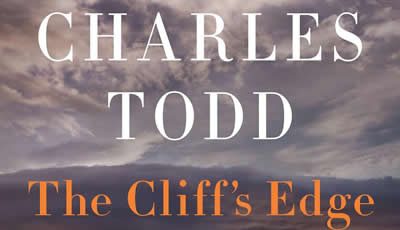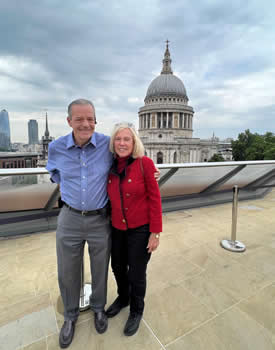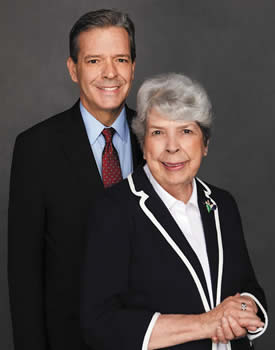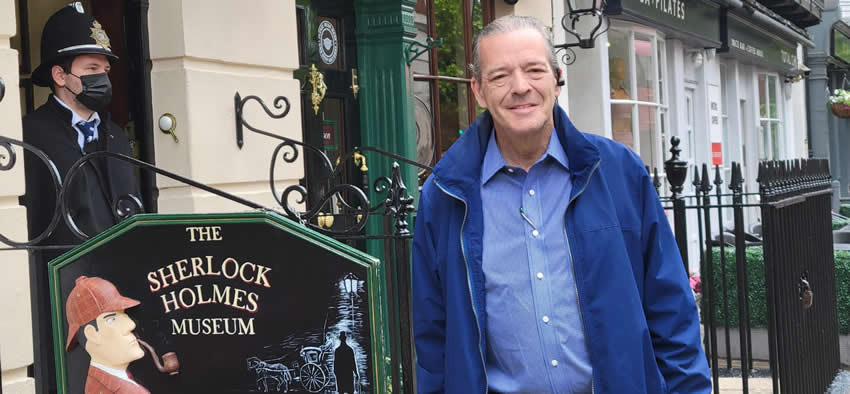

Latest Books Up Close: Charles Todd
Murder and Menace in the English Countryside
 By K.L. Romo
By K.L. Romo
It’s 1917 in bestselling author Charles Todd’s THE CLIFF’S EDGE (Book 13 of the Bess Crawford mystery series). Surgical nurse Bess Crawford is back from the battlefields of World War I and not sure about what’s next in her future.
Bess receives a call from her cousin Melinda asking her to travel to Yorkshire to assist Melinda’s friend, Lady Beatrice, through a gallbladder surgery. But no sooner does Bess arrive than news of a terrible accident involving Lady Beatrice’s godson reaches them. Since Beatrice is in no shape to travel, Bess reluctantly agrees to make the trek to the remote village of Scarfdale to assist. Once there, she realizes there is more at play than meets the eye. As more people end up dead, Bess finds herself in the middle of a police investigation. She knows she’s keeping secrets, but which ones are based on fact, and which are lies?
Bess is determined to help solve the mystery—who is killing people close to the Neville family? She’s become an unwitting amateur sleuth, trying to decipher the facts surrounding the deaths. Things are not what they seem.
Charles Todd once again gives readers a character to cheer for. Especially in the early 20th century, most women had little control over their futures, not to mention an opportunity to develop a career. Bess’ gritty determination to provide surgical care on the front lines of World War I, then later, her resolve to aid anyone needing her help, gives us an intimate look into the life of one woman’s unconventional opportunities.
Here, The Big Thrill speaks with Todd about his and his mother’s love of history, their personal historical research, and Bess’s evolving character.
What was your initial inspiration for the character of battlefield nurse Bess Crawford?
After the 10th Ian Rutledge mystery, we felt that the woman’s perspective of the war was missing. We enjoyed writing The Murder Stone, a mystery thriller about the life of Francesca Hatton for that reason and felt there was more to tell. We also kept coming up with ideas for mysteries that were a better fit for an amateur sleuth. And so Bess Crawford was born.
How has she evolved from Book 1 of the series to Book 13?
Bess began the war in A Duty to the Dead as a young woman who was independent but had never embarked on a journey with a career and purpose of her own. Still, she had a sense of duty to serve. Had she been a man, she would have followed her father into the Army. The daughter of a regimental colonel, she was accustomed to the military life, dealing with the army and being surrounded by soldiers who faced combat, especially in India.
Bess begins as a woman with grit and determination that remains throughout the series. Her clear sense of right and wrong drives her to find the truth. As her career has progressed during the war, her experiences as a nurse and caregiver propel her to prominence in Queen Alexandra’s Nursing Corps. She also learns a lot about herself and the world around her. She develops from a young, somewhat innocent woman into the Bess who survives the war and is now defining her future.
I’m so sorry about Caroline’s passing. Did you both work on THE CLIFF’S EDGE?
As always, we worked on THE CLIFF’S EDGE together through the initial draft that was sent to our editor and agent shortly before her passing. I took the book through the editing process for acceptance and then the copy edits and first pass proofs.
Tell us more about your personal research of England (through traveling) and your historical research of World War I.
My love of history was nurtured early by my parents, especially my mother. Like most boys, war fascinated me. My great uncles served during WWI, and it was wonderful to talk to veterans and their families, with veterans sharing their experiences. Many veterans (of any war) do not share the harsh reality of war with civilians. Often, I learned more from their families.
As I grew up, the question of war brought me to study what caused war and what effects war had long after it was over. WWI is a fascinating example. From the end of the royal houses in Europe and Russia to the effects of the Treaty of Versailles, we’re still faced with the impact that WWI had on our history and current events.

Todd and his significant other, literary agent Dianna Collier, in front of the dome of Saint Paul’s Cathedral in London.
We do our research in person by going to the places we write about. Our primary sources for writing come from letters and newspapers of the time period. We know how the war ended. Our characters lived not knowing what we know now. Their perspective is the most important part of our works. Villages are a microcosm of English society. Never had a country sacrificed so much in war. We see their resilience and determination in the places we visited. From the cherished Great War memorials that are places of pride to the lists of the local men who fought and died, this conflict marks the villages.
We don’t arrive with cameras and talk to the community about our work. We are there to learn about them. Often, we make friends we stay in touch with years after our visits. The British don’t like to talk about themselves. Visiting village markets and talking to craftsmen and vendors about their wares and profession helps. Many Britons have dogs, and, as animal lovers ourselves, it’s a great way to get conversations started. Besides the war, we learn about the community, the people and how they interact. We learn the history and culture of each place we visit. As Americans, we think of England as one place, and yet it is as varied as the United States.
Are there any interesting historical facts included in the novel that might surprise readers?
There are several facts we included in THE CLIFF’S EDGE that will surprise some readers. We work hard not to just recite facts but weave them into the story. The facts we learn lead us in our search to solve the heart of the mystery. Describing the facts will clue the readers into things they will learn as they read.
- The Big Thrill Recommends: ONE BIG HAPPY FAMILY by Jamie Day - September 16, 2024
- The Big Thrill Recommends: ONLY ONE SURVIVES (Video) by Hannah Mary McKinnon - July 30, 2024
- The Big Thrill Recommends: WHAT YOU LEAVE BEHIND by Wanda M. Morris - June 27, 2024


